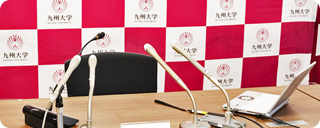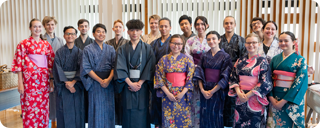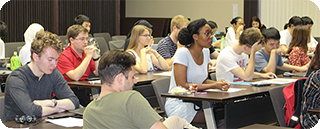研究・産学官民連携 Research
Proposing new value through collaboration across interdisciplinary boundaries
- TOP
- Research
- Research at Kyushu University
- Recent Studies at the Faculty of Design
- Proposing new value through collaboration across interdisciplinary boundaries
Research Projects and Initiatives
Recent Studies at Faculty of Design
Proposing new value through collaboration across interdisciplinary boundaries
Department of Strategic Design, Faculty of Design
Associate Professor Satoru Tokuhisa
My laboratory is called the interdisciplinary design lab, and we emphasize collaboration across interdisciplinary boundaries and the fusion of knowledge to create new approaches. Therefore, we collaborate not only with industry, government, and academia, but also with various organizations and experts. My laboratory has three main research areas.
The first area is service design. This area analyzes various actors in any context, the resources they possess, and the relationships between them, with the aim of designing optimal beneficiary experiences and the ecosystems that enable them. For example, in collaboration with TOPPAN Holdings Inc. as a partner, we designed a patient guidance service for general hospitals utilizing TOPPAN's digital twin platform TransBots® [1]. Additionally, with support from the Japan Society for the Promotion of Science (JSPS) Grant-in-Aid for Scientific Research (Exploratory Research), we are developing and evaluating a framework (Figure 1) consisting of design principles, tools, and processes based on Web3 philosophy [2].

Figure 1. Web3 service design framework: Web3 service ecosystem map
The second area is human-computer interaction. This field analyzes humans and phenomena in any context and aims to propose new value to users through interactions between humans and computers. For example, Annisa Dhia Baswedan, a master's student, proposed an AR game called “The Adventure in Science Museum” (Figure 2) featuring anthropomorphic characters set in a science museum, using the Fukuoka Science Museum as a field, and presented it at the international conference CHI Play 2024 [3]. Additionally, Junsheng Qiu, a doctoral student, proposed a UX evaluation method for SaaS products in B2B settings called “Dual-Track UX” and presented it at the international conference CHI 2025 [4].

Figure 2. The Adventure in Science Museum
The third area is innovation management. This area targets companies and local governments and aims to manage the creation and establishment of innovation within organizations, including the planning and development of new businesses, the design of internal institutions, and behavioral changes within organizations. For example, using a distilled coconut juice production project that originated from fieldwork in East Timor as a case study, we are writing a book on a methodology for weaving innovation in resource-constrained regions (Figure 3) [5]. In addition, at the request of NTT Data MSE +Next Design Office, we have been providing technical guidance for four years to help the company build a service design organization [6].


Figure 3. Weaving regional innovations

Although the three research areas appear to be different at first glance, they share the common keyword of interaction design. Interaction means the design of mutual interaction. Service design aims to propose new value through the design of interactions between service providers and service beneficiaries, human-computer interaction between humans and computers, and innovation management between actors and resources inside and outside an organization.
References
[1] TOPPAN Holdings Inc. 2022. Toppan Printing Conducts Demonstration of Nursing Support Using Remote-Controlled Robots. https://www.holdings.toppan.com/ja/news/2022/03/newsrelease220302_2.html
[2] National Institute of Informatics. 2023. Development and Evaluation of a Service Design Methodology Based on Web3 Concepts for Revitalizing Local Governments. https://kaken.nii.ac.jp/ja/grant/KAKENHI-PROJECT-23K17490/
[3] Annisa Dhia Baswedan and Satoru Tokuhisa. 2024. The Adventure in Science Museum: AR Game Featuring Anthropomorphized Companion to Enhance Learning Experience in Science Museum. In Companion Proceedings of the 2024 Annual Symposium on Computer-Human Interaction in Play (CHI PLAY Companion '24). Association for Computing Machinery, New York, NY, USA, 18–23. https://doi.org/10.1145/3665463.3678802
[4] Junsheng Qiu and Satoru Tokuhisa. 2025. Dual-Track UX: A User Experience Evaluation Method for B2B SaaS Development. In Proceedings of the Extended Abstracts of the CHI Conference on Human Factors in Computing Systems (CHI EA '25). Association for Computing Machinery, New York, NY, USA, Article 206, 1–7. https://doi.org/10.1145/3706599.3719968
[5] Tokuhisa, Satoru. 2018. Weaving regional innovations. Tokyo. NTT Publishing. https://www.nttpub.co.jp/book/list/?keyword=978-4-7571-2372-4
[6] NTT Data MSE. 2025. NTT Data +Next Design Lab. https://nttd-mse.com/servicedesign/?utm_source=kyushu-u&utm_medium=referral&utm_campaign=plus_next_sangaku_2025
Research Laboratory Website: https://interdisciplinary-design-lab.studio.site/en
■Contact
Department of Strategic Design, Faculty of Design
Associate Professor Satoru Tokuhisa
- TOP
- Research
- Research at Kyushu University
- Recent Studies at the Faculty of Design
- Proposing new value through collaboration across interdisciplinary boundaries































